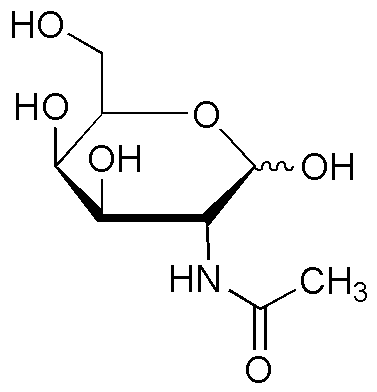N-Acetyl-D-galactosamine is widely utilized in research focused on
- Biotechnology: It serves as a substrate for glycosylation studies, helping researchers understand carbohydrate-protein interactions and their implications in cell signaling.
- Pharmaceutical Development: This compound is crucial in the synthesis of glycoproteins and glycolipids, which are essential for drug formulation and delivery systems.
- Diagnostics: It is used in the development of diagnostic assays for diseases that involve glycan biomarkers, enhancing the accuracy of disease detection.
- Cell Culture: N-Acetyl-D-galactosamine is employed in cell culture media to promote the growth of specific cell types, particularly in research involving immune responses.
- Research on Autoimmune Diseases: It plays a role in studying the mechanisms of autoimmune diseases, providing insights into potential therapeutic targets and treatments.
General Information
Properties
Safety and Regulations
Applications
N-Acetyl-D-galactosamine is widely utilized in research focused on
- Biotechnology: It serves as a substrate for glycosylation studies, helping researchers understand carbohydrate-protein interactions and their implications in cell signaling.
- Pharmaceutical Development: This compound is crucial in the synthesis of glycoproteins and glycolipids, which are essential for drug formulation and delivery systems.
- Diagnostics: It is used in the development of diagnostic assays for diseases that involve glycan biomarkers, enhancing the accuracy of disease detection.
- Cell Culture: N-Acetyl-D-galactosamine is employed in cell culture media to promote the growth of specific cell types, particularly in research involving immune responses.
- Research on Autoimmune Diseases: It plays a role in studying the mechanisms of autoimmune diseases, providing insights into potential therapeutic targets and treatments.
Documents
Safety Data Sheets (SDS)
The SDS provides comprehensive safety information on handling, storage, and disposal of the product.
Product Specification (PS)
The PS provides a comprehensive breakdown of the product’s properties, including chemical composition, physical state, purity, and storage requirements. It also details acceptable quality ranges and the product's intended applications.
Certificates of Analysis (COA)
Search for Certificates of Analysis (COA) by entering the products Lot Number. Lot and Batch Numbers can be found on a product’s label following the words ‘Lot’ or ‘Batch’.
*Catalog Number
*Lot Number
Certificates Of Origin (COO)
This COO confirms the country where the product was manufactured, and also details the materials and components used in it and whether it is derived from natural, synthetic, or other specific sources. This certificate may be required for customs, trade, and regulatory compliance.
*Catalog Number
*Lot Number
Safety Data Sheets (SDS)
The SDS provides comprehensive safety information on handling, storage, and disposal of the product.
DownloadProduct Specification (PS)
The PS provides a comprehensive breakdown of the product’s properties, including chemical composition, physical state, purity, and storage requirements. It also details acceptable quality ranges and the product's intended applications.
DownloadCertificates of Analysis (COA)
Search for Certificates of Analysis (COA) by entering the products Lot Number. Lot and Batch Numbers can be found on a product’s label following the words ‘Lot’ or ‘Batch’.
*Catalog Number
*Lot Number
Certificates Of Origin (COO)
This COO confirms the country where the product was manufactured, and also details the materials and components used in it and whether it is derived from natural, synthetic, or other specific sources. This certificate may be required for customs, trade, and regulatory compliance.


